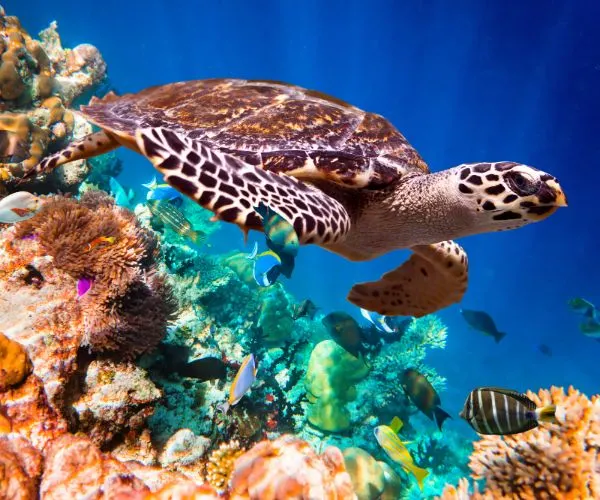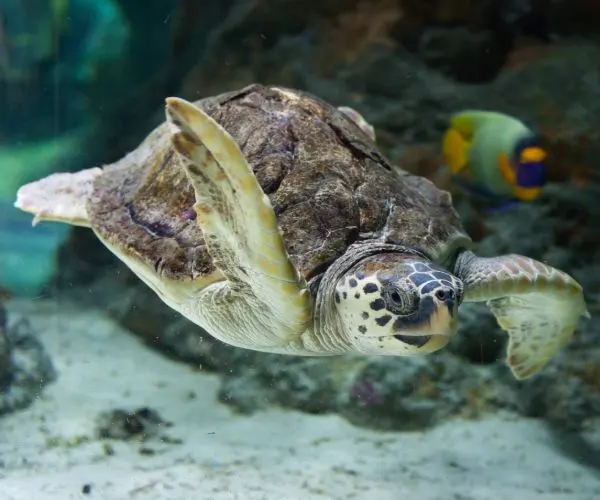There are 11 different types of turtles in Europe, 6 of which are freshwater species and the other 5 being sea turtle species.
Turtles are mostly adaptive and are found on every single continent except for Antarctica. Europe has recorded about five or so species, not including sea turtles.
Due to the climate of Europe, turtles will choose to make homes out of the more temperate areas such as Italy, Spain, or the Mediterranean, and more.
While most turtles are legal to keep, it is typically illegal to trade, import, breed, or sell turtles under EU law. It is illegal to release turtles into the wild.
Turtles can make really awesome pets for those who find them interesting and know what needs to be done to care for them.
However, Europe is somewhat limited in options since there are not many species that live in the colder countries and the turtle trade is quite dry in these areas.
Even so, there are still many interesting species to learn about, especially if you are a keeper or enthusiast.
Turtles in Europe
Here are some turtles you might find in Europe:
1. European Pond Turtle

Quick Facts
- Experience Level: Beginner to Intermediate
- Family: Emydidae
- Scientific Name: Emys orbicularis
- Common Names: European Pond Terrapin, European Pond Tortoise
- Adult Size: 5 to 15 inches
- Lifespan: 28 years
- Distribution: Germany, Austria, Switzerland, Poland, Hungary, Albania, Yugoslavia, Czech Republic, Slovakia, Italy, Sardinia, France, Corsica, Spain, Balearic Islands, Portugal, Greece, Turkey, Bulgaria, Romania, Iran, Soviet Union, Latvia, Lithuania
Quick Care Requirements
- Tank Size: 40 gallons per turtle
- Food: Fish, amphibians, mollusks, and aquatic worms
- UVB Lighting: Needed
- Water Temperature: 77 to 85 degrees Fahrenheit
- Basking Spot Temperature: 90 degrees Fahrenheit
While they are widely distributed throughout Europe, they are actually native to the Western Palearctic.
Their appearances will vary depending on geography, but they can be identified by their dark carapace and skin with bright yellow, almost gold-like, speckles all throughout their body.
2. Spanish Pond Turtle

Quick Facts
- Experience Level: Not Recommended
- Family: Geoemydidae
- Scientific Name: Mauremys leprosa
- Common Names: Spanish Leprous Pond Turtle, Mediterranean Pond Turtle, Mediterranean Turtle
- Adult Size: Around 7 to 8 inches
- Lifespan: 25 years
- Distribution: The Mediterranean Basin,France, Portugal, Spain
This species of turtle is seen in the wild and less in the turtle-keeping community.
They are typically olive-green or grey in color and have long necks. Their coloration is pretty uniform throughout their body but there may be some yellow striping of the neck or cream colorations in some individuals.
3. Balkan Pond Turtle

Quick Facts
- Experience Level: Intermediate
- Family: Geoemydidae
- Scientific Name: Mauremys rivulata
- Common Names: Western Caspian Terrapin
- Adult Size: 7 to 10 inches
- Lifespan: Unknown
- Distribution: Albania, Bosnia and Herzegovina, Bulgaria, Croatia, Greece, Macedonia, Montenegro, Serbia.
To keep these freshwater turtles as pets, you will need a lot of outdoor space and a garden pond in order for them to thrive.
These guys are a uniform grey-green or dark grey with small cream-yellow stripes along their neck and sometimes their limbs.
They can be found in the Balkan Peninsula and a few of the Mediterranean islands of the Middle East.
4. Sicilian Pond Turtle

Quick Facts
- Experience Level: Not Recommended
- Family: Emydidae
- Scientific Name: Emys trinacris
- Adult Size: 6 to 7 inches
- Lifespan: Unknown
- Distribution: Italy
This wild turtle is only endemic to Sicily, Italy. It is not recommended as a pet since there are not many of them and they have not been studied in captivity.
They are typically poached for the pet trade, which is the biggest threat to this already vulnerable species.
They have a dark grey or black body and carapace with almost an entirely yellow plastron. They can also sometimes have yellow dots all over their skin and shell.
5. The Caspian Turtle

Quick Facts
- Experience Level: Expert
- Family: Geoemydidae
- Scientific Name: Mauremys caspica
- Common Names: Striped-Neck Terrapin, Caspian Terrapin
- Adult Size: 10 inches
- Lifespan: 18 years old
- Distribution: European Turkey
These turtles are not best as pets due to their very specific eating habits and needs.
They are tan, grey to black in color, while some may have a brown shell and thin stripes along their neck. They have an oval-shaped, low domed carapace.
Other individuals may have a yellow plastron.
They are highly aquatic turtles that mostly don’t do well in captivity due to owners not being able to meet their needs.
6. African Softshell Turtle

- Experience Level: Expert
- Family: Trionychidae
- Scientific Name: Trionyx triunguis
- Common Names: Nile Softshell Turtle
- Adult Size: 44 inches
- Lifespan: 24 to 45 years
- Distribution: Greece, Turkey
These large turtles are almost extinct, with only 3 of their species left. Conservationists are trying to get viable sperm to create a fourth.
They are brown-olive grey with white spots all over their bodies. Some individuals might even have yellow rings on them.
Their plastrons are white and their noses are snorkel-like with a thick piece of skin over their mouths.
These turtles are not only big, but they’re super aggressive, meaning that attempting to hold one can mean losing a limb since they have pretty long necks and a sharp mouth.
These are only a few of the reasons that they are not the most suitable house pet. They are definitely an interesting species to check out and learn about, especially since there are only a few left, although, we hope that will change.
Sea Turtles in Europe
Here are some sea turtles you might find in Europe:
7. Leatherback Sea Turtle

Quick Facts
- Scientific Name: Dermochelys Coriacea
- Family: Dermochelyidea
- Adult Size: About 6 to 7 feet
- Weight: Between 1200 and 1450 pounds
- Lifespan: 30 years
- Conservation Status: Vulnerable
- Habitat: They like warm waters and can be found in every ocean except the Arctic. They will inhabit calm, shallow lagoons or bays. They love to nest on sand, sloping beaches with good vegetation.
- Clutch Size: 100 to 110 eggs.
- Food: Mainly jellyfish but sometimes some fish and other marine creatures.
- Appearance: It is the only sea turtle that lacks a hard shell, which is dark grey to black in color, sometimes showcasing scattered white spots or blotches. Their dark carapace is elongated and flexible with long ridges running down its length.
- Distribution: Portugal
8. Hawksbill Sea Turtle

Quick Facts
- Scientific Name: Eretmochelys Imbricata
- Family: Cheloniidae
- Adult Size: 30 to 35 inches
- Weight: between 100 to 155 pounds
- Lifespan: About 30 to 50 years
- Conservation Status: Critically Endangered
- Habitat: Tropical, rocky waters, mangroves, lagoons, or near tropical coral reefs.
- Clutch Size: Anything from 140 to 200 eggs; Nesting about 4 times each season or every 2 weeks
- Food: Omnivorous; They will feed on sea urchins, jellyfish, mollusks, marine algae, and sponges!
- Appearance: They get their name from their unique beak-like mouths, which are similar to hawks. They will show off an elongated, oval-shaped, amber-colored, shell that has unique patterns on it. Their also amber flippers have claws at the “elbows” of them as well!
- Distribution: In the Mediterranean Sea off Southern Europe
9. Loggerhead Sea Turtle

Quick Facts
- Scientific Name: Caretta caretta
- Family: Cheloniidae
- Adult Size: between 35 inches and 3 feet
- Weight: 154 pounds
- Lifespan: 70 to 80 years
- Conservation Status: Endangered
- Habitat: Shallow, subtropical coastal regions
- Clutch Size: 100 to 125 eggs; nesting 4 to 5 times per season
- Food: Carnivorous; they will eat clams, conches, and crabs!
- Appearance: Hard-shelled turtles with a reddish-brown color, a yellow underbelly, and long flippers. They have a large head with a defined jaw.
- Distribution: Turkey, Greece, Tunisia, Cyprus, Libya, and southern Italy.
10. Green Sea Turtle

Quick Facts
- Scientific Name: Chelonia Mydas
- Family: Cheloniidae
- Adult Size: 3 to 4 feet
- Weight: 300 to 400 pounds
- Lifespan: 80 to 100 years
- Conservation Status: Endangered
- Habitat: Tropical and subtropical waters in bays and shores by the coastline; anywhere with seagrass beds
- Clutch Size: 110 to 115 eggs; Nesting 2 to 5 times per season
- Food: Primarily herbivorous, eating seagrass and seaweed, sometimes algae. Sometimes younger green sea turtles will feed on worms, aquatic insects, or small crustaceans.
- Appearance: They have nonretractable, small heads and a heart-shaped, brown carapace. They will wear a greenish hue on their scaley skin, will have a cream-colored underside, and beady eyes.
- Distribution: In the Mediterranean Sea off Southern Europe
11. Kemp’s Ridley Sea Turtle

Quick Facts
- Scientific Name: Lepidochelys Kempii
- Family: Cheloniidae
- Adult Size: About 25 inches
- Weight: 77 to 100 pounds
- Lifespan: 30 years
- Conservation Status: Critically endangered
- Habitat: Shallow muddy or sandy coastal lines
- Clutch Size: 100 to 110 eggs; nesting 2 to 3 times per season
- Food: They love crabs, especially blue crabs, but will also eat shrimps, clams, and mussels
- Appearance: Triangular head with a slightly hooked beak, greyish-green, circular carapace with a light yellow or cream plastron. Their undersides may also be a pale yellow to cream color.
- Distribution: England, the Northern Atlantic coasts of France, Spain
Conclusion
While Europe might not have many species of turtles, there are some great ones that are well-distributed throughout the continent.
There are also some sea turtles that will visit the shores of the continent here and there, even if they don’t choose to nest there.
We hope that this article was informative and possibly gave you some ideas of what you can look out for in terms of turtle species in Europe.
If you have any questions or just want to add something, please let us know in the comment section below!
We’d love to hear from you. Happy Herping!
References
- https://en.wikipedia.org/wiki/Category:Turtles_of_Europe
- https://en.wikipedia.org/wiki/List_of_reptiles_of_Europe#Turtles
- https://www.dw.com/en/eu-moves-to-protect-sea-turtles/a-36358699

Jim Mueller
Wednesday 23rd of November 2022
I don’t see any mention of tortoises which live in Mediterranean Europe; i.e. Herman’s, Greek, Marginated, etc.